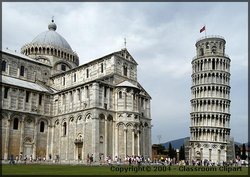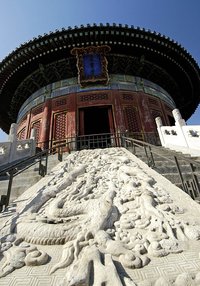Architecture
|
|
Architecture is the art and science of designing buildings and structures. A wider definition would include within its scope the design of the total built environment, from the macrolevel of town planning, urban design, and landscape architecture to the microlevel of furniture.

| Contents |
Architectural history

Early human settlements were essentially rural. As surplus of production began to occur, rural societies transformed into urban ones and cities began to evolve. In many ancient civilizations such as the Egyptians' and Mesopotamians' architecture and urbanism reflected the constant engagement with the divine and the supernatural. However, the architecture and urbanism of the Classical civilizations such as the Greek and the Roman evolved from more civic ideas and many new building types emerged. Architectural styles developed and texts on architecture began to be written. These became canons to be followed in important works, especially religious architecture. Some examples of canons are the works of Vitruvius, the Kaogongji of ancient China and Vaastu Shastra in ancient India. In Europe in the Classical and Medieval periods, buildings were not attributed to specific individual architects who remained anonymous. Guilds were formed by craftsmen to organize their trade. Over time the complexity of buildings and their types increased. General civil construction such as roads and bridges began to be built. Many new building types such as schools, hospitals, and recreational facilities emerged.
Islamic architecture all by itself merits a special discussion. The concept of Islamic architecture can be understood in several ways. But perhaps a concise way of defining it would be to say that Islamic architecture is simply the architecture characteristic of predominantly Islamic societies as well as similar architecture elsewhere.
Using this definition, Islamic architecture has a long and complex history beginning in the 7th century CE continuing today. Examples can be found throughout the countries that are, or were, Islamic - from Morocco and Spain to Iran, and Indonesia. Other examples can be found in areas where Muslims are a minority. Islamic architecture includes mosques, madrasas, caravansarais, palaces, and mausolea of this large region.
With the Renaissance and its emphasis on the individual and humanity rather than religion, and with all its attendant progress and achievements, a new chapter began. Buildings were ascribed to specific architects - Michaelangelo, Brunelleschi, Leonardo da Vinci - and the cult of the individual had begun. But there was no dividing line between artist, architect and engineer, or any of the related vocations. At this stage, it was still possible for an artist to design a bridge as the level of structural calculations involved were within the scope of the generalist.
With the consolidation of knowledge in scientific fields such as engineering and the rise of new materials and technology, the architect began to lose ground on the technical aspects of building. He therefore, cornered for himself another playing field - that of aesthetics. There was the rise of the "gentleman architect" who usually dealt with wealthy clients and concentrated predominantly on visual qualities derived usually from historical prototypes. In the 19th century Ecole des Beaux Arts in France, the training was toward producing quick sketch schemes involving beautiful drawings without much emphasis on context.
Meanwhile, the Industrial Revolution laid open the door for mass consumption and aesthetics started becoming a criterion even for the middle class as ornamented products, once within the province of expensive craftsmanship, became cheaper under machine production. Such products lacked the beauty and honesty associated with the expression of the process in the product.
The dissatisfaction with such a general situation at the turn of the twentieth century gave rise to many new lines of thought that in architecture served as precursors to Modern Architecture. Notable among these is the Deutscher Werkbund, formed in 1907 to produce better quality machine-made objects. The rise of the profession of industrial design is usually placed here. Following this lead, the Bauhaus school, founded in Germany in 1919, consciously rejected history and looked at architecture as a synthesis of art, craft, and technology.
When Modern architecture first began to be practiced, it was an avant-garde movement with moral, philosophical, and aesthetic underpinnings. Truth was sought by rejecting history and turning to function as the generator of form. Architects became prominent figures and were termed masters. Later modern architecture moved into the realm of mass production due to its simplicity and economy.
However, a reductive quality began to be perceived in modern architecture by the general public from the 1960s. Some reasons cited for this are its perceived lack of meaning, sterility, ugliness, uniformity, and psychological effects.
The architectural profession responded to this partly by attempting a more populist architecture at the visual level, even if at the expense of sacrificing depth for shallowness, a direction called Postmodernism. Robert Venturi's contention that a "decorated shed" (an ordinary building which is functionally designed inside and embellished on the outside) was better than a "duck" (a building in which the whole form and its function are considered together) gives an idea of this approach.
Another part of the profession, and also some non-architects, responded by going to what they considered the root of the problem. They felt that architecture was not a personal philosophical or aesthetic pursuit by individualists; rather it had to consider the everyday needs of people and use technology to give a livable environment. The Design Methodology Movement involving people such as Chris Jones, Christopher Alexander started searching for a more inclusive process of design in order to lead to a better product. Extensive studies on areas such as behavioral, environmental, and social sciences were done and started informing the design process.
As many other concerns began to be recognized and the complexity of buildings began to increase in terms of aspects such as services, architecture started becoming more multi-disciplinary than ever. Architecture now required a team of professionals in its making, an architect being one among the many, sometimes the leader, sometimes not. This is the state of the profession today. However, individuality is still cherished and sought for in the design of buildings seen as cultural symbols - the museum or fine arts center has become a showcase for new experiments in style: today Deconstructivism, tomorrow maybe something else.
Scope and intentions
According to the very earliest surviving work on the subject, Vitruvius' De Architectura, good buildings should have Beauty (Venustas), Firmness (Firmitas) and Utility (Utilitas); architecture can be said to be a balance and coordination among these three elements, with none overpowering the others. A modern-day definition sees architecture as addressing aesthetic, structural and functional considerations. However, looked at another way, function itself is seen as encompassing all criteria, including aesthetic and psychological ones.
Architecture is a multi-disciplinary field, including within its fold mathematics, science, art, technology, social sciences, politics, history, philosophy, and so on. In Vitruvius' words, "Architecture is a science, arising out of many other sciences, and adorned with much and varied learning: by the help of which a judgement is formed of those works which are the result of other arts". He adds that an architect should be well versed in fields such as music, astronomy, etc. Philosophy is a particular favourite; in fact one frequently refers to the philosophy of each architect when one means the approach. Rationalism, empiricism, structuralism, poststructuralism, and phenomenology are some directions from philosophy influencing architecture.
Theory and practice
The relevance of theory in informing practice cannot be overemphasised, though many architects shun theory. Vitruvius continues: "Practice and theory are its parents. Practice is the frequent and continued contemplation of the mode of executing any given work, or of the mere operation of the hands, for the conversion of the material in the best and readiest way. Theory is the result of that reasoning which demonstrates and explains that the material wrought has been so converted as to answer the end proposed. Wherefore the mere practical architect is not able to assign sufficient reasons for the forms he adopts; and the theoretic architect also fails, grasping the shadow instead of the substance. He who is theoretic as well as practical, is therefore doubly armed; able not only to prove the propriety of his design, but equally so to carry it into execution."
Architecture and buildings
The difference between architecture and building is a subject matter that has engaged the attention of many. Architecture is also the art of designing the human built environment. Buildings, landscaping, and street designs may be used to impart both functional as well as aesthetic character to a project. Siding and roofing materials and colors may be used to enhance or blend buildings with the environment. Building features such as cornices, gables, entrances, and window treatments and borders may be used to soften or enhance portions of a building. Landscaping may be used to create privacy and block direct views from or to a site and enhance buildings with colorful plants and trees. Streetside features such as decorative lighting, benches, meandering walkways, and bicycle lanes may either enhance or degrade the experience of a project site for passersby, pedestrians, and cyclists.
Conclusion
Buildings are one of the most visible productions of man, and vary greatly in design, function, and construction implementation across the globe from industrialized countries to "third world", or developing countries. The role of the Architect also varies accordingly. The vision (or lack of) that Architects project on the society in which they practice has a profound effect on the built environment, and consequently on the people who interact with that environment. The skills of the architect are sought after in many situations ranging from complex building types such as the Skyscraper, Hospital, Stadium, Airport, etc. to less complicated project types such as commercial and residential buildings and development. Many types of projects or examples of Architecture can be seen as cultural and political symbols. Generally, this is what the public perceives as architecture. The role of the architect, though changing, has been central to the successful (and sometimes unsuccessful) design and implementation of the built environment in which we live. There is always a dialogue between society and the architect. And what results from this dialogue can be termed architecture - as a product and as a discipline.
See also
- Architect
- Architectural history
- Architectural style
- Architectural theory
- Architecture timeline
- Building code
- Building construction
- Building material
- Cathedral architecture
- Classical architecture
- Environmental design
- Forms in architecture
- Landscape architecture
- List of architects
- List of architecture firms
- List of buildings
- Structural engineering
- Vernacular architecture
- World Heritage Sites
Clip Art and Pictures
- Building and Architecture Clipart (https://classroomclipart.com/image/category/architecture-and-buildings-clipart.htm)
- Architecture Pictures (https://classroomclipart.com/image/category/architecture-and-building-photos.htm)
- Pictures of Countries and Cities of the World (https://classroomclipart.com/image/category/world-countries-photos.htm)



